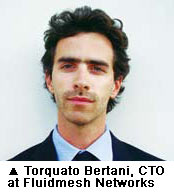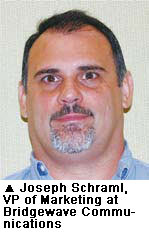With the dawning of IP-based video surveillance and megapixel cameras, wireless access control solutions and intrusion alarms, the quality of data transmission is more critical now than ever. A&S explores how transmission providers from Ethernet to wireless to fiber optics keep their offerings competitive.
Video surveillance requires high bandwidth and low latency, making it more demanding than access control or intrusion detection. A surveillance system is only as good as its network, enabling transmission from the cameras to the control center. “This is why transmission can become the ‘Achilles heel' of a project, especially if cameras need to be deployed in areas where no networking infrastructure exists,” said Ksenia Coffman, Marketing Manager at Firetide
Geographically dispersed IP video networks will continue to grow, and with it, the challenges of managing them, said Roni Klein, VP of Sales at Verint Video Solutions APAC, Verint Systems.
IMS Research reported the worldwide video surveillance market to be worth US$9.5 billion in 2009, and transmission technologies including Ethernet, wireless and fiber optics form a significant part of this market, said Corin Moorhead, Product Manager for COE.
Though IMS Research downscaled its growth forecast from 6 to 3 percent for  2009, transmission technologies have strong market potential, especially for IP systems.
2009, transmission technologies have strong market potential, especially for IP systems.
Design and Options
A transmission system's lifespan, cost, installation ease and future-proofing capability are considerations at a project's onset. “The communication layer is key and can be considered a basis for building the security system,” said Avi Shabtay, GM of Private and Alternate Networks Line of Business, Alvarion.
Popular transmission options include power line communication (PLC), Ethernet, wireless and fiber optics. Installation sizes range from small (hundreds of meters) for a gas station or retail shop; to medium (tens of kilometers) such as SMBs and large supermarkets; and to large (hundreds of kilometers), such as city surveillance and critical infrastructure.
 PLC is useful in domestic applications, but is more difficult at bigger complex sites. Large buildings such as hospitals host a huge number of electronics that inject a great deal of noise onto the power lines, said Alastair McLeod, MD of the U.K. at Veracity.
PLC is useful in domestic applications, but is more difficult at bigger complex sites. Large buildings such as hospitals host a huge number of electronics that inject a great deal of noise onto the power lines, said Alastair McLeod, MD of the U.K. at Veracity.
Any type of power line technology needs continual repeaters to amplify the signal to achieve greater distances, said Geoffrey Smith, VP of Sales and Marketing at Proxim Wireless.
Wireless installations cost less than wired alternatives for labor. For projects that need to be completed rapidly and demand portability or scalability, wireless solutions may be the right choice, said Brian Carlson, VP and GM of Global Sales at Azalea Networks. Wireless signals, however, can be disrupted.
Both Ethernet and fiber optics require cabling. PoE can deliver power but is limited by distance, whereas fiber optics runs long distances but cannot deliver power.
by distance, whereas fiber optics runs long distances but cannot deliver power.
Connecting Through Ethernet
Every IP-based device requires a network switch port, more likely several in a chain. “We estimate that more than 20 percent of such devices, grown from less than 5 percent two years ago, are now being powered by PoE,” McLeod said. With Ethernet, projects can range from a handful to nearly 2,000 cameras or other devices.
The three major advantages of cabled Ethernet transmission are lower cabling costs, easy expansion and ability to support hybrid infrastructure through adapters.
 With budgets still tight, making use of existing analog cables to upgrade to IP is an attractive choice for many.
With budgets still tight, making use of existing analog cables to upgrade to IP is an attractive choice for many.
Installation challenges can occur when using Ethernet-over-coaxial adapters on old cables, which may not allow for the full data rate (100 megabits per second each way).
Wireless Topologies
“To ensure the deployment gets off the ground successfully, you must perform site surveys to determine issues involving line-of-sight (LOS) obstructions — buildings, tunnels or hills, radio frequency environment, distances, access to camera sites and electrical power,” Coffman said.
The global wireless transmission market for 2009 is about $1.5 billion, with security and mission-critical applications portioning $250 million, said Torquato  Bertani, CTO at Fluidmesh Networks.
Bertani, CTO at Fluidmesh Networks.
Available wireless topologies are point-to-point (PtP), point-to-multipoint (PtMP) and multipoint-to-multipoint (wireless mesh). Without additional antennae, radios, routers or other accessories, wireless products achieve roughly 14 kilometers on average, and 25 kilometers maximum.
“Today's solutions are based on standards, with better performance, scalability and price/performance,” Carlson said. IEEE 802.11 standards for WLAN in the 2.4-, 3.6- and 5-GHz frequency bands set the bar for wireless solutions.
PtP
PtP systems can be expensive, but suit larger security  deployments, such as remote surveillance. “In 2008, the PtP market for the 5-GHz band was estimated at $140 million,” Shabtay said.
deployments, such as remote surveillance. “In 2008, the PtP market for the 5-GHz band was estimated at $140 million,” Shabtay said.
The goal for a network design is to minimize the number of hops from the source to the destination, Shabtay said. However, as distance increases, the capacity decreases due to signal degradation. Link distances for millimeter wave operators (60- to 90-GHz) may be a challenge during inclement weather.
Added antennae can provide greater distance and improve performance. “Rain is the impediment that causes challenges in stretching the distance of these millimeter wave solutions. Depending on the engineering of the link, distances are in the range of 3 to 5 kilometers,” said Joseph Schraml, VP of Marketing at Bridgewave Communications.
Finding a suitable location to provide clear LOS between two radios is key to  maximizing performance.
maximizing performance.
For situations that require non-LOS (NLOS) performance, enhanced radio technologies such as orthogonal frequency division multiple access can penetrate light obstructions and still deliver quality video, Shabtay said.
Carlson added that, “Most systems are LOS or ‘near LOS,' unless you are using 800- or 900-mHz radio frequency to achieve the necessary propagation for NLOS.
High-capacity backhaul aggregates traffic from base stations, adding low latency. “Performance is likely foremost on the buyer's mind when choosing a backhaul solution,” Schraml said.
PtMP
PtMP is suitable for wider area coverage, such as city surveillance. WiMax is  currently the only standardized solution for wireless PtMP networks, but can be expensive and inefficient. Alternatives are wireless outdoor router protocols.
currently the only standardized solution for wireless PtMP networks, but can be expensive and inefficient. Alternatives are wireless outdoor router protocols.
Three considerations are frequency support, multicast support and overcoming interference.
Solutions that support multicast transmission greatly reduce the bandwidth needed for every camera or IP device connected.
Interference with other 5-GHz radios is a huge challenge for PtMP systems. Supporting the entire 5-GHz band on a single platform provides maximum flexibility. To enhance interference mitigation and improve radio communication, WiMAX 16e breakthroughs include multiple inputs multiple outputs (MIMO), large FFT size filters (1024), HARQ and more to increase maximum performance in license-exempt environments, Shabtay said.
However, today's devices have advanced to pick  between networks and choose the best performing one to use, said Massimo Scavo, International Sales Manager of Selea. It is also cost-effective to use existing wireless infrastructure rather than take up greenfield projects, and many opt for 3-G as a backhaul network.
between networks and choose the best performing one to use, said Massimo Scavo, International Sales Manager of Selea. It is also cost-effective to use existing wireless infrastructure rather than take up greenfield projects, and many opt for 3-G as a backhaul network.
MIMO takes different data streams and, using two to four antennae, allows users to transmit more than four times the data over twice the distance.
Mesh
The flexibility of mesh allows it to be deployed in any of the above scenarios — PtP for backhaul, PtMP or “true” mesh for complete redundancy. Unlike PtMP, any mesh node can act as a “head end,” allowing multiple command centers to be set up at various points on the network. “The equipment needed for a 15-node mesh is the same as for a 500-node mesh — you just grow the coverage area by adding meshes,” Coffman said.
High-bandwidth capabilities of MIMO 802.11n wireless  mesh make it an ideal solution for video, the most bandwidth-intensive and latency-intolerant application. MIMO mesh can deliver up to 300 megabits per second with 0.9-millisecond latency, ideal for municipal, transportation and industrial security, Coffman said.
mesh make it an ideal solution for video, the most bandwidth-intensive and latency-intolerant application. MIMO mesh can deliver up to 300 megabits per second with 0.9-millisecond latency, ideal for municipal, transportation and industrial security, Coffman said.
Mesh networks are self-healing for resiliency: Redundant links eliminate single points of failure, while multiple paths overcome LOS issues. The use of multiple intermediary nodes can slow down video transmission, Klein said. One node may slow multiple cameras, causing latency and interfering with image quality.
The right antennae can make or break mesh deployment. For video surveillance, directional antennae are appropriate because they concentrate the signal the most and are less susceptible to interference, Coffman said.
Fiber Optics
Fiber optics cost more but is more stable than wireless transmission. “There  seems to be a lack of understanding in the market that fiber optics can provide all the advantages of a synchronous digital hierarchy or Ethernet solution, without having to compromise on bandwidth,” said Sara Bullock, Executive Sales Director of AMG Systems.
seems to be a lack of understanding in the market that fiber optics can provide all the advantages of a synchronous digital hierarchy or Ethernet solution, without having to compromise on bandwidth,” said Sara Bullock, Executive Sales Director of AMG Systems.
Transmission should be specified to at least 10-bit digital encoding, for improved signal-to-noise ratio with less distortion of the original image. “Recent developments in small form factor pluggable optics are allowing for transmission at distances of up to 160 kilometers on single mode fiber,” Moorhead said.
The outstanding technical challenge is fiber splicing, simplified with semiautomated fusion splicers, Moorhead said.